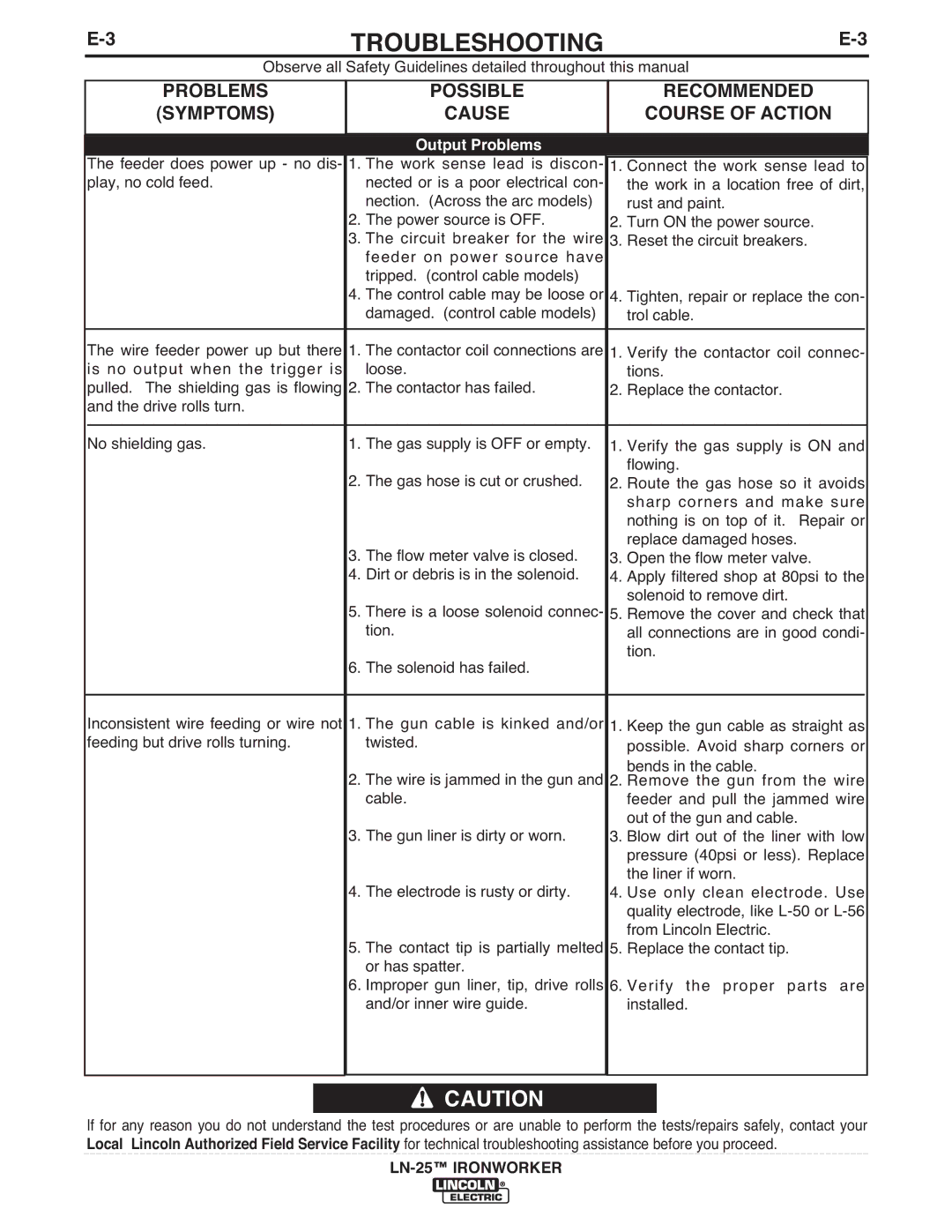
TROUBLESHOOTING | ||
|
|
|
| Observe all Safety Guidelines detailed throughout this manual |
|
|
|
|
PROBLEMS
(SYMPTOMS)
POSSIBLE
CAUSE
RECOMMENDED
COURSE OF ACTION
Output Problems
| The feeder does power up - no dis- | 1. | The work sense lead is discon- | 1. | Connect the work sense lead to | |
| play, no cold feed. |
| nected or is a poor electrical con- |
| the work in a location free of dirt, | |
|
|
| nection. (Across the arc models) |
| rust and paint. | |
|
| 2. | The power source is OFF. | 2. | Turn ON the power source. | |
|
| 3. | The circuit breaker for the wire | 3. | Reset the circuit breakers. | |
|
|
| feeder on power source have |
|
|
|
|
|
| tripped. (control cable models) |
|
|
|
|
| 4. | The control cable may be loose or | 4. | Tighten, repair or replace the con- | |
|
|
| damaged. (control cable models) |
| trol cable. | |
|
|
|
|
|
|
|
| The wire feeder power up but there | 1. | The contactor coil connections are | 1. | Verify the contactor coil connec- | |
| is no output when the trigger is |
| loose. |
| tions. | |
| pulled. The shielding gas is flowing | 2. | The contactor has failed. | 2. | Replace the contactor. | |
| and the drive rolls turn. |
|
|
|
|
|
|
|
|
|
|
| |
| No shielding gas. | 1. | The gas supply is OFF or empty. | 1. | Verify the gas supply is ON and | |
|
| 2. | The gas hose is cut or crushed. |
| flowing. | |
|
| 2. | Route the gas hose so it avoids | |||
|
|
|
|
| sharp corners and make sure | |
|
|
|
|
| nothing is on top of it. Repair or | |
|
| 3. | The flow meter valve is closed. |
| replace damaged hoses. | |
|
| 3. | Open the flow meter valve. | |||
|
| 4. | Dirt or debris is in the solenoid. | 4. | Apply filtered shop at 80psi to the | |
|
| 5. | There is a loose solenoid connec- |
| solenoid to remove dirt. | |
|
| 5. | Remove the cover and check that | |||
|
|
| tion. |
| all connections are in good condi- | |
|
| 6. | The solenoid has failed. |
| tion. | |
|
|
|
|
| ||
|
|
|
|
|
|
|
| Inconsistent wire feeding or wire not | 1. | The gun cable is kinked and/or | 1. | Keep the gun cable as straight as | |
| feeding but drive rolls turning. |
| twisted. |
| possible. Avoid sharp corners or | |
|
| 2. | The wire is jammed in the gun and |
| bends in the cable. | |
|
| 2. | Remove the gun from the wire | |||
|
|
| cable. |
| feeder and pull the jammed wire | |
|
| 3. | The gun liner is dirty or worn. |
| out of the gun and cable. | |
|
| 3. | Blow dirt out of the liner with low | |||
|
|
|
|
| pressure (40psi or less). Replace | |
|
| 4. | The electrode is rusty or dirty. |
| the liner if worn. | |
|
| 4. | Use only clean electrode. Use | |||
|
|
|
|
| quality electrode, like | |
|
| 5. | The contact tip is partially melted |
| from Lincoln Electric. | |
|
| 5. | Replace the contact tip. | |||
|
|
| or has spatter. |
|
|
|
|
| 6. | Improper gun liner, tip, drive rolls | 6. | Verify the proper parts are | |
|
|
| and/or inner wire guide. |
| installed. | |
|
|
|
|
|
|
|
![]()
![]() CAUTION
CAUTION
If for any reason you do not understand the test procedures or are unable to perform the tests/repairs safely, contact your Local Lincoln Authorized Field Service Facility for technical troubleshooting assistance before you proceed.
